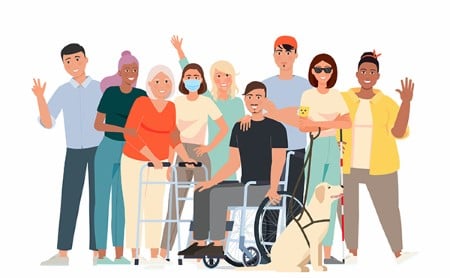Embedded: Meeting Needs for Disability-Inclusive Emergency Preparedness in South Carolina
June 21, 2022 | Adrianna Evans, Dawn E. Wesenberg
 Curt Decker—Executive Director the National Disability Rights Network—describes inclusive emergency planning well: “People with access and functional needs have to be considered at every phase and every aspect of the planning process. When inclusion is an afterthought tacked on to an established process, we typically find that systems are not designed to effectively serve all citizens.”
Curt Decker—Executive Director the National Disability Rights Network—describes inclusive emergency planning well: “People with access and functional needs have to be considered at every phase and every aspect of the planning process. When inclusion is an afterthought tacked on to an established process, we typically find that systems are not designed to effectively serve all citizens.”
As the emergency operations incident command was preparing to stand-down in December 2021, the South Carolina Department of Health and Environmental Control (SCDHEC) was shifting to a new posture in the next phase of the pandemic. At this time, the focus of the disability and preparedness specialist was to understand, assess, and focus the lens through which health agencies have met (and will better meet) the public health emergency needs of people living with disabilities. (In this context, "people living with disabilities" encompasses all access and functional needs.)
Disability Inclusion in an Emergency Preparedness Context
ASTHO’s Ten Essential Questions for Disability Inclusion in Health Agencies (en Español) helps health agencies improve inclusivity of people living with disabilities in public health programs. The disability and preparedness specialist applied this tool and found the following useful insights on disability inclusion in the context of public health emergency preparedness.
In the first question, ASTHO’s tool addresses understanding the impact of a public health issue on people living with disabilities. To promote health equity, it is imperative that jurisdictions and agencies address the access and functional needs of people living with disabilities during and after an emergency. Inclusive emergency plans should address access needs by ensuring universal accessibility to social services, information, transportation, or any other necessary resource.
ASTHO’s tool encourages agencies to gain understanding of various disability rules and laws. Applying the tool in the context of emergency preparedness points to federal disability laws such as the Americans with Disabilities Act, the Post-Katrina Emergency Reform Act, and the Pandemic and All Hazards Preparedness Act. The Assistant Secretary for Preparedness and Response (ASPR) Hospital Preparedness Program (HPP), CDC’s Public Health Emergency Preparedness (PHEP) Cooperative Agreement, and the Public Health Accreditation Board collectively reinforce requirements regarding access and functional need inclusion in planning. As indicated by ASTHO’s tool, these policies are at the base of preparedness planning for people living with disabilities.
ASTHO’s tool also encourages consulting with people living with disabilities, their families, and disability service providers to accurately meet the needs of different groups. The process of managing stakeholder needs is fluid, but necessary to inform disability-inclusive decision making. To both meet the requirements laid out by federal laws and agencies and the needs of people with disabilities, members of the disability community should be invited to attend meetings, share experiences, and function as planning consultants.
Operationalizing ASTHO’s Tool
ASTHO’s tool was crucial to fostering conversations about inclusive planning in South Carolina. Using the ASTHO tool is a way to assess and incorporate inclusive planning into any size jurisdiction, benefiting the entire community. What’s more, it resulted in bringing a center for independent living (CIL) to the integrated planning process for the first time in South Carolina. This CIL serves people living with disabilities in 22% of South Carolina counties, provided services to more than 1,000 consumers last year, and partners with 75 additional local businesses, schools, and community organizations.
The perspectives in the tool also helped create a disability preparedness toolkit for South Carolina. The toolkit promotes disability inclusion throughout all programmatic activities and aims to increase capacity for inclusive preparedness planning in the health agency overall. This toolkit compiles resources for strategic planning and staff training, lists disability partners, and provides a planning template for assigning agency staff tasks related to inclusivity.
Using this tool at the start of any planning process provides a structured, non-judgmental window to see innovative and applicable solutions and can be adapted to any jurisdiction. Its simple format promotes reflection on the impact, laws, and local history regarding disability inclusion in jurisdiction workgroups and partnerships. The tool challenges users to shift their perspective from a government-centric approach to a community-centric approach.